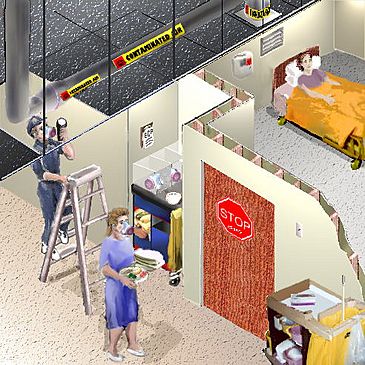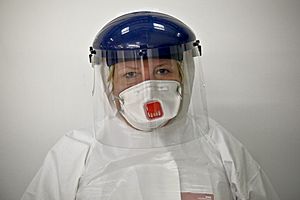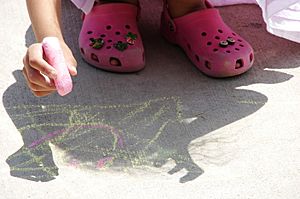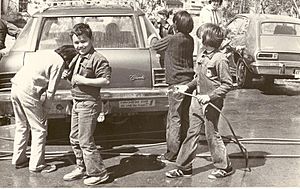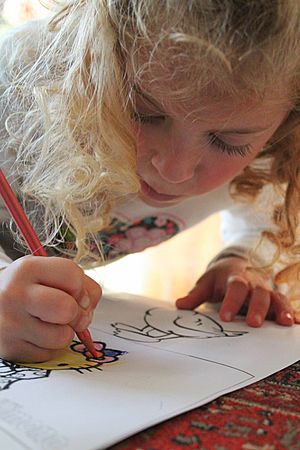Isolation (health care) facts for kids
In health care facilities, isolation represents one of several measures that can be taken to implement infection control: the prevention of contagious diseases from being spread from a patient to other patients, health care workers, and visitors, or from outsiders to a particular patient (reverse isolation).
Various forms of isolation exist
Isolation is most commonly used when a patient is known to have a contagious (transmissible from person-to-person) viral or bacterial illness.
Special equipment is used in the management of patients in the various forms of isolation. These most commonly include items of personal protective equipment (gowns, masks, and gloves) and engineering controls (positive pressure rooms, negative pressure rooms, laminar air flow equipment, and various mechanical and structural barriers). Dedicated isolation wards may be pre-built into hospitals, or isolation units may be temporarily designated in facilities in the midst of an epidemic emergency.
Contents
Importance
Contagious diseases can spread to others through various forms.
Four types of infectious disease transmission can occur:
- contact transmission, which can be through direct physical contact, indirect contact through fomites, or droplet contact in which airborne infections spread short distances
- vehicular transmission, which involves contaminated objects
- airborne transmission, which involves spread of infectious particles through air
- vector transmission, which is spread through insects or animals. Depending on the contagious disease, transmission can occur within a person's home, school, worksite, health care facility, and other shared spaces within the community.
Self-isolation
Self-isolation or home isolation is the act of voluntarily quarantining oneself to prevent infection of oneself or others. The practice was used in the 2019–20 coronavirus pandemic.
Key features are:
-
- staying at home
- separating oneself from other people—for example, trying not to be in the same room as other people at the same time
- asking friends, family members or delivery services to carry out errands, such as getting groceries, medicines or other shopping
- asking delivery drivers to leave items outside for collection.
30 Great activity ideas for kids to do in self-isolation
There are plenty of activities kids can do if they need to self-isolate.
Being away from school, group sports, friends and relatives can be hard, but keeping yourself busy can help.
Here's some inside and outside activities you can do.
Outside
- Gardening - do some weeding, plant some seeds
- Find some flowers to arrange and put in a vase; find leaves, flowers, sticks to make a collage; find leaves to make leaf rubbings
- Treasure hunts or scavenger hunts
- Chalk drawing on pavements around the house (if allowed)
- Make some shadow drawings outside
- Find some rocks to paint
- Time yourself running a circuit of your backyard or around your house using a smart phone timer or a clock. Try to beat your best time.
- Paint the windows using shaving cream, similar to finger painting
- Clean the windows!
- Outdoor party games like egg and spoon race or three legged races
- Have picnics in the yard
- Wash your parents car or wash your bike/scooter/skateboard
- Make an obstacle course
- Make an outside fort or camp
- Make houses in the garden for fairies
Inside
- Clean/rearrange your bedroom
- Make cubbies and forts inside using cushions, sheets, couches and pillows
- Make some play doh
- Find some flowers to press inside some books between baking paper
- Make stained glass windows using different colored celophane
- Make your own board game
- Make some of your own greeting and birthday cards to use later
- Make some origami animals
- Write a letter to a friend or relative or even your teachers at school
- Make paper chains to put around the room
- Make some paper planes. Have a contest to see which plane travels the furthest
- Try some french knitting or finger knitting or regular knitting
- Have a disco. String up christmas lights and turn off the lights to create some atmosphere
- Make a video diary each day of what you're doing, send it to a relative or a friend
- Make a "play store" and use pantry items to sell
(Here is a list of some tradition children's games too)
Related pages
Images for kids
-
Traffic sign in South Carolina encouraging people to 'stay home' during the COVID-19 pandemic.
See also
 In Spanish: Aislamiento (sanidad) para niños
In Spanish: Aislamiento (sanidad) para niños


